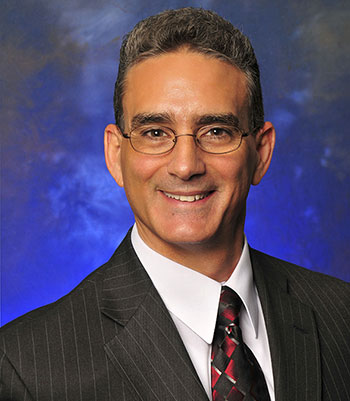
Al Illustrato, Vice President of Facilities and Administration at Tampa International: “It’s so important for us to give our guests a great experience. We’re committed to doing that throughout our construction, and certainly when we’re done we’re going to give passengers a great experience – they’ll be able to see a bit of the flair and flavour of our region in the terminal.”
The Tampa Bay area – a rapidly-growing metropolitan region with nearly three million residents – sits on the Gulf of Mexico, and boasts some of the US’ best beaches. Tampa International Airport, the gateway to the west coast of Florida, is embarking on a near-$1 billion master plan that will provide a significantly enhanced level of customer service, and demonstrate the “flair and flavour” of the region.
The airport began the process of updating its master plan in 2011 and the final plan, approved in 2013, outlines three expansion phases to accommodate 35 million passengers – over double the current annual throughput. A ‘build as demand dictates’ approach to growth means each phase will be based on passenger volume, with completion of the first phase slated for 2017.
The passenger experience is at the very heart of these plans, and Al Illustrato, Vice President of Facilities and Administration at Tampa International, enthused about the technologies and efficiencies that will deliver a first-class airport journey for travellers.
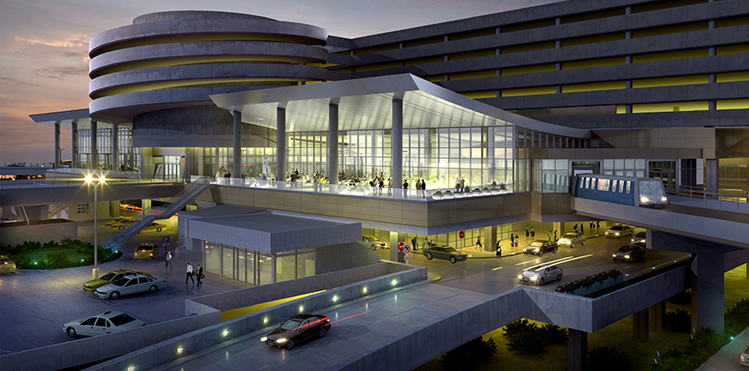
The expansion of the main terminal will see over 55,000 sq ft – roughly the equivalent of a football field – added to the third floor. Making the terminal more open and spacious will result in improved sightlines and better wayfinding for passengers.
The first phase addresses the immediate need to decongest the curbside areas, roads and main terminal. It involves expanding the main terminal by more than 55,000 sq ft, building a new 2.6 million sq ft consolidated rental centre near the airport entrance, and constructing a 1.4-mile automated people mover.
Illustrato explained that a design-build philosophy is being used for all major components, which allowed some early design work up front, while early enabling construction activities could begin while the design process was still ongoing. Ground breaking officially took place on 20 November 2014. Illustrato heralded the design, which will transform the existing facility into an open and airy terminal to help improve passenger flow and elevate the travel experience.
The expansion will add over 55,000 sq ft – roughly the equivalent of a football field – to the third floor of the terminal. The renovation includes lounge areas and distinct spaces for business travellers and families, green zones with plenty of plants, and art installations. Making the terminal more open and spacious will result in improved sightlines and better wayfinding for passengers.
Other major elements of the overall project include demolition and reconstruction of the Taxiway J Bridge. Taxiway J has been closed as work begins to make room for the airport’s new automated people mover. The master plan also includes a new, consolidated rental car site, which Illustrato commented will relieve some of the rental car flow and congestion from the terminal area.
The challenges
When undertaking renovation and expansion of existing facilities, the most immediate challenge is maintaining a first-class customer experience. Illustrato speaks fluently about managing these complexities and delivering “a great experience” to passengers and other stakeholders. The scheduling is another important challenge, with interdependencies between different projects. “One of the things that has worked well as a development model at Tampa Airport is the design-build approach,” Illustrato commented. “Because we have designer and builder together, we work with our stakeholders, our guest services, and other major airport departments to ensure we are designing the phasing and scheduling in a way that minimises the disruption to tenant operations and to our guests at the airport.”
Initial feedback from the airport’s customer surveying has been excellent, with no negative comments following the first few weeks of construction activity.
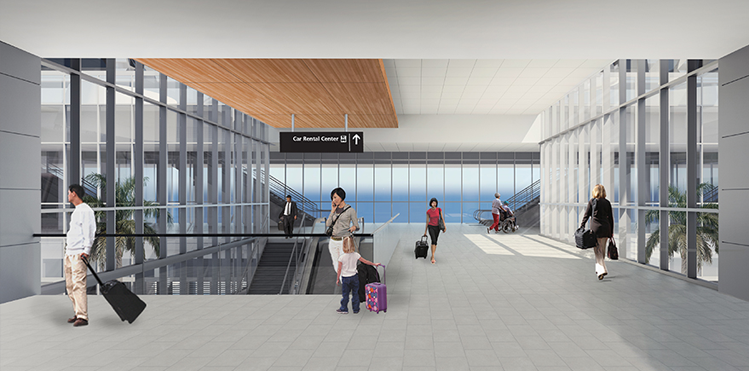
The expanded terminal will be more open and spacious, with improved sightlines and better wayfinding for passengers. The master plan also includes a new, consolidated rental car site, which will relieve some of the rental car flow and congestion from the terminal area.
Key figures at a glance
- The 270,000 sq ft undergoing renovations on the third floor of the main terminal is equivalent to four-and-a-half football fields.
- Over 55,000 sq ft is being added to the main terminal, including more than 23,000 sq ft for new outdoor terraces.
- The project includes renovation of 24 elevators and replacement of 1,112 linear feet of escalators.
- 114,000 sq ft of new tile flooring is being placed.
“A great guest experience”
Throughout the myriad challenges of undertaking major construction work in a live airport environment, it is the attention to detail that is among the most impressive aspects. These minutiae include the use of temporary construction walls designed to closely resemble permanent walls, which feature renderings and information telling passengers what is happening and what is to come. These efforts to minimise disruption and the visual impact of construction are all part of the focus on ensuring a first-class customer experience. “It’s so important for us to give our guests a great experience,” Illustrato enthused. “We’re committed to doing that throughout our construction, and certainly when we’re done we’re going to give passengers a great experience – they’ll be able to see a bit of the flair and flavour of our region in the terminal.”
The airport has also hired 22 temporary customer service representatives, whose role is to assist passengers throughout their airport journey, particularly around the more challenging parts of the construction areas, ensuring wayfinding is clear and concession areas are clearly identifiable. These are in addition to the airport’s usual guest representatives. “We feel it’s important to have a human to interact with,” Illustrato explained. “On any given day a traveller may be anxious, so if the routing is a little different for them, we recognise right up front that that’s something we need to ease them through, and be ready to offer them that good customer service representative assisting them through the new area.”
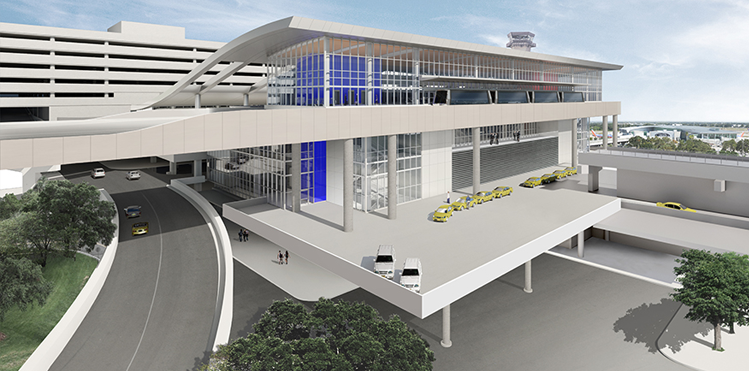
The first phase of Tampa Airport’s master plan includes a 1.4-mile automated people mover.
Engine of economic development
The $943 million (€830m) expansion will be a big economic engine in the community in several ways. It is expected to generate or sustain nearly 9,000 construction-related jobs over the next three years, and that’s predicted to have a $370 million (€325m) economic impact on the region. It will also encourage air service development and Tampa Airport is expanding its route network domestically and internationally. Illustrato outlined the collaborative approach that has been the hallmark of its network expansion success over the last couple of years. “Our marketing, air service development and business development teams work extensively with local visitor bureaux and Chambers of Commerce,” he said. “The Tampa Bay region is comprised of so many different areas – from downtown Tampa, to St. Petersburg, to Clearwater, to other areas of Hillsborough County. So it’s critically important for the airport to partner with all of these entities to ensure that when we’re talking to airlines, they know we have the full backing of all of our local partners.”
The results are tangible – new international services secured over the past two years include Edelweiss Air to Zurich, Copa Airlines to Panama, Lufthansa to Frankfurt, and an expanded service from British Airways. “One other I should mention from the leisure perspective is Alaska Airways, which now has a direct service from Tampa to Seattle,” Illustrato added. “Significantly, that opens up the cruise ship sector as well, so we’re working with organisations like AAA Travel to raise awareness that these things are available to and from Tampa.”
Another important example of the airport’s economic reach is its investment in women-owned, minority-owned and disadvantaged businesses, which will total more than $120 million (€105m) over the next three years. The airport is also in the midst of a complete overhaul of its concessions programme, which is intended to improve customer service, optimise revenue opportunities for the airport and concessionaires, and capture the spirit of the Tampa Bay area. It is a complete revamping of 59 concession locations in retail and food & beverage, which will allow greater competition and more choice for the customer. Importantly, this will expand opportunities for Airport Concessions Disadvantage Business Enterprises (ACDBE). The award of contracts is scheduled for summer 2015, with construction of the new concessions to begin this year and be complete in 2017.
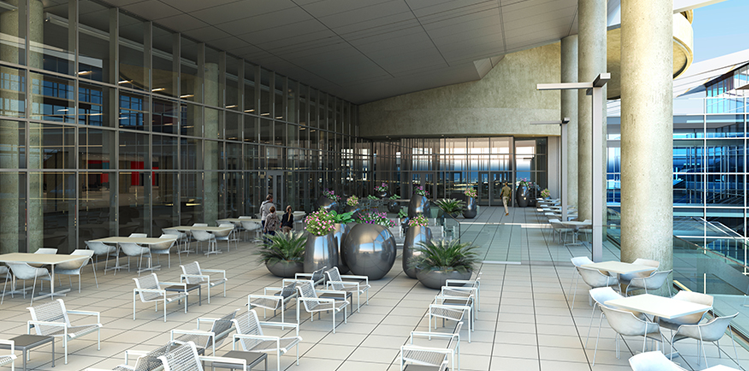
The near-$1 billion master plan for Tampa Airport will deliver a great guest experience, augmented by details including new outdoor terraces.
Now is the right time to be undertaking these developments as the airport looks towards doubling its throughput over the next 20 years. “We’re at around 17 million passengers now,” Illustrato explained. “We know once traffic levels build to a certain point it’s much more challenging to construct these projects, so our belief is to try to complete them just in time. Our master plan identifies what we need to do, and right now it’s that timeframe to get ready so that by 2017, when we expect our traffic to be at a 19 million passenger level, we’re well prepared and can then accommodate the continued growth for the next 20 years.”







